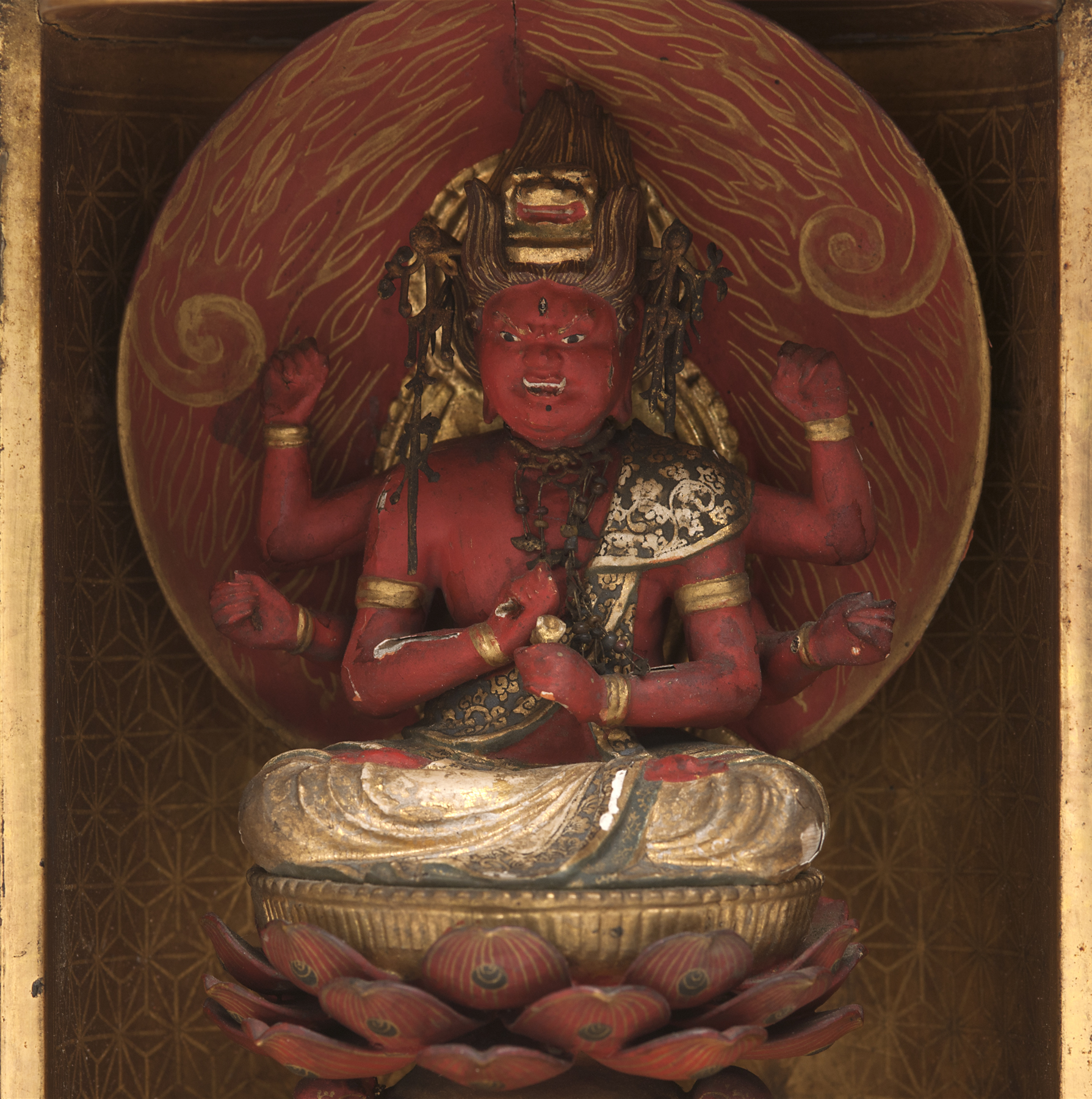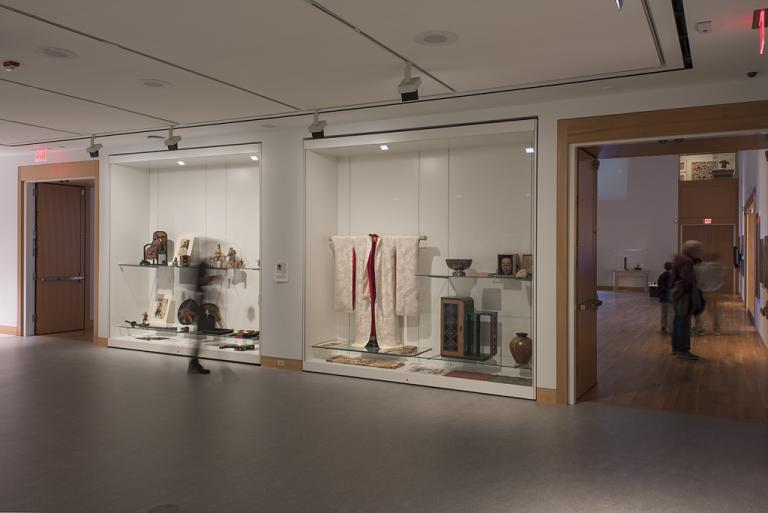zushi (portable shrine) containing Aizen Myōō, unknown maker from Japan
Artwork Overview

Object Height (Height): 16.51 cm
Object Height (Height): 6 1/2 in
If you wish to reproduce this image, please submit an image request
Images
Label texts
Exquisitely embellished with gold, bronze, and lacquer ornamental detail, the owner of this portable shrine likely used it for private prayers and devotions. This shrine is dedicated to the esoteric Buddhist deity Aizen-Myōō (King of Esoteric Knowledge Tinted by Love or Lust). A fearsome deity with a fiery halo, Aizen-Myōō employs his wrathful nature for the good of Buddhism by forcefully preventing mortals from falling prey to the temptations of their human desire. The deity’s attributes reflect his role in Buddhism. His third eye symbolizes his enlightened abilities of perception. His multiple arms hold the weapons and religious implements he uses to carry out his duties. His lion headdress, fangs, and brilliant red skin all manifest his awesome power.
This zushi served as a personal shrine, providing a portable and intimate ritual space for its owner. Housed within the zushi sits the Buddhist deity Aizen Myōō (Bright King of Love and Lust), who belongs to the esoteric Buddhist grouping of the Bright Kings (myōō). Bright Kings appear wrathful, but they serve a compassionate purpose, fighting off the ignorance that obstructs a practitioner’s path to Nirvana, the final transcendent state and goal of Buddhism.
At the turn of the 20th century, many Western collectors exotified Japan as a mystical and culturally static society, intrinsically different from any Western nation. These attitudes and beliefs rendered Japanese imagery a subject of fascination for such collectors. In keeping with this perception of Japan, Western audiences also extoled the virtues and technical skills of the “traditional” Japanese craftsperson. With its vibrant and intricately rendered polychromy and gilding and its frightening, yet benevolent icon, this zushi would have appealed to the exotic interests of collectors.
Tap the image above and swipe to see the shrine closed and a detailed image.
This small, portable shrine called a zushi in Japanese merges sacred and personal space because it can be held in the hand while serving as a container for a Buddhist image. Though it resembles a simple box covered in plain black lacquer when its doors are closed, extravagant designs and a colorful sculpture of a deity emerge when the doors open. This deity, Aizen Myōō, is associated with love and the control of passions, an important quality required to achieve enlightenment. The deity’s red color indicates his association with emotion, while his fierce expression is meant to inspire awe. The presence of Aizen Myōō makes the box sacred.
Ornamentation appears throughout the interior, seen in the blazing flames, the circle behind Aizen Myōō, and the gold patterning on the backs of the doors. These somewhat extravagant touches are not simply decorative; they embody the idea of shōgon, or sacred adornment. These embellishments enhance the holiness of the deity that may serve as a focus of meditation or prayer for the beholder of the zushi. Thus, the zushi allows for a special connection between the viewer and the sacred. Instead of the worshipper going to the space, the worshipper may hold the space.
Text by Matt Hobart
This shrine is dedicated to the esoteric Buddhist deity Aizen-Myo¯o¯ (“King of Esoteric Knowledge Tinted by Love or Lust”). A fearsome deity with a fiery halo, Aizen-Myo¯o¯ employs his wrathful nature for the good of Buddhism by forcefully preventing mortals from falling prey to the temptations of their human desire. The deity’s attributes reflect his role in Buddhism. His third eye symbolizes his enlightened abilities of perception. His multiple arms hold the weapons and religious implements he uses to carry out his duties. His lion headdress, fangs, and brilliant red skin all manifest his awesome power. Exquisitely embellished with gold, bronze, and lacquer ornamental detail, this portable shrine likely was used for the private devotions of a wealthy individual patron.
Exhibition Label:
"Corpus," Apr-2012, Amanda Wright
This shrine is dedicated to the esoteric Buddhist deity Aizen-Myo¯o¯ (“King of Esoteric Knowledge Tinted by Love or Lust”). A fearsome deity with a fiery halo, Aizen-Myo¯o¯ employs his wrathful nature for the good of Buddhism by forcefully preventing mortals from falling prey to the temptations of their human desire. The deity’s attributes reflect his role in Buddhism. His third eye symbolizes his enlightened abilities of perception. His multiple arms hold the weapons and religious implements he uses to carry out his duties. His lion headdress, fangs, and brilliant red skin all manifest his awesome power. Exquisitely embellished with gold, bronze, and lacquer ornamental detail, this portable shrine likely was used for the private devotions of a wealthy individual patron.
Exhibition Label:
"Compassionate Beings: Japanese Buddhist Art," Sep-2009, Kris Ercums
Housed within this portable shrine is a small sculpture of the Esoteric Buddhist deity Aizen-Myōō or the “King of Esoteric Knowledge Tinted by Love or Lust.” The fierce appearance of this deity represents his ability to deter people from being distracted from enlightenment by human desires. Interestingly, he was popular in Japan but was not commonly worshiped in other Buddhist countries like Korea and China.
Exhibition Label:
“The Sacred and the Secular: Buddhist Imagery in Religious and Popular Contexts,” Oct-2005, Hillary Pedersen
Housed within this portable shrine is a small sculpture of the Esoteric Buddhist deity Aizen-Myōō or the “King of Esoteric Knowledge Tinted by Love or Lust”. The fierce appearance of this deity represents his ability to deter people from being distracted from enlightenment by human desires. Interestingly, he was popular in Japan but was not commonly worshiped in other Buddhist countries like Korea and China.
The deity has a lion headdress, red skin, and sits on a red lotus. The headdress illustrates his strength while red suggests the rays of the sun. He also has three eyes–the third one symbolizing his great knowledge and insight. The six arms of Aizen-Myōō demonstrate his great power, and are needed to hold several weapons and Buddhist implements, now lost on this sculpture. All these features described in a Buddhist scripture distinguish this deity from many others.
This type of lacquered wooden cabinet is called a zushi in Japanese and functions here as a portable shrine, but can be much larger and contain any number of different items for storage.
Exhibitions
Rachel Straughn-Navarro, curator
Sherry Fowler, curator
Kate Meyer, curator
Emma Scioli, curator
Paul Stock, curator
Kate Meyer, curator


















